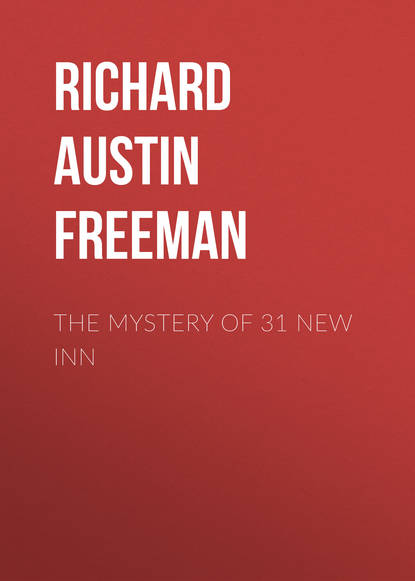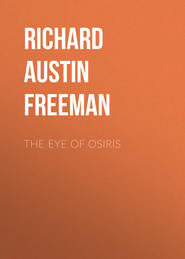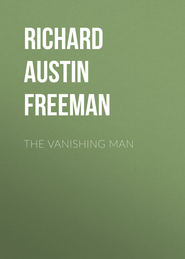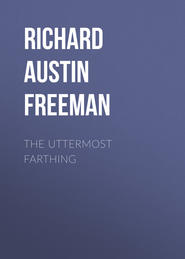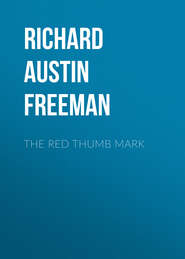По всем вопросам обращайтесь на: info@litportal.ru
(©) 2003-2024.
✖
The Mystery of 31 New Inn
Настройки чтения
Размер шрифта
Высота строк
Поля
"Then you travelled about the seventh of a mile in a north-easterly direction and we draw a line an inch long at an angle of forty-five degrees to the right of the north and south line. From the end of that we carry a line at an angle of fifty-six and a quarter degrees to the left of the north and south line, and so on. The method is perfectly simple, you see."
"Perfectly; I quite understand it now."
I went back to my chair and continued to read out the entries from the notebook while Thorndyke laid off the lines of direction with the protractor, taking out the distances with the dividers from a scale of equal parts on the back of the instrument. As the work proceeded, I noticed, from time to time, a smile of quiet amusement spread over my colleague's keen, attentive face, and at each new reference to a railway bridge he chuckled softly.
"What, again!" he laughed, as I recorded the passage of the fifth or sixth bridge. "It's like a game of croquet. Go on. What is the next?"
I went on reading out the notes until I came to the final one:
"'Nine twenty-four. South-east. In covered way. Stop. Wooden gates closed.'"
Thorndyke ruled off the last line, remarking: "Then your covered way is on the south side of a street which bears north-east. So we complete our chart. Just look at your route, Jervis."
He held up the board with a quizzical smile and I stared in astonishment at the chart. The single line, which represented the route of the carriage, zigzagged in the most amazing manner, turning, re-turning and crossing itself repeatedly, evidently passing more than once down the same thoroughfares and terminating at a comparatively short distance from its commencement.
"Why!" I exclaimed, the "rascal must have lived quite near to Stillbury's house!"
Thorndyke measured with the dividers the distance between the starting and arriving points of the route and took it off from the scale.
"Five-eighths of a mile, roughly," he said. "You could have walked it in less than ten minutes. And now let us get out the ordnance map and see if we can give to each of those marvellously erratic lines 'a local habitation and a name.'"
He spread the map out on the table and placed our chart by its side.
"I think," said he, "you started from Lower Kennington Lane?"
"Yes, from this point," I replied, indicating the spot with a pencil.
"Then," said Thorndyke, "if we swing the chart round twenty degrees to correct the deviation of the compass, we can compare it with the ordnance map."
He set off with the protractor an angle of twenty degrees from the north and south line and turned the chart round to that extent. After closely scrutinizing the map and the chart and comparing the one with the other, he said:
"By mere inspection it seems fairly easy to identify the thoroughfares that correspond to the lines of the chart. Take the part that is near your destination. At nine twenty-one you passed under a bridge, going westward. That would seem to be Glasshouse Street. Then you turned south, apparently along the Albert Embankment, where you heard the tug's whistle. Then you heard a passenger train start on your left; that would be Vauxhall Station. Next you turned round due east and passed under a large railway bridge, which suggests the bridge that carries the Station over Upper Kennington Lane. If that is so, your house should be on the south side of Upper Kennington Lane, some three hundred yards from the bridge. But we may as well test our inferences by one or two measurements."
"How can you do that if you don't know the exact scale of the chart?"
"I will show you," said Thorndyke. "We shall establish the true scale and that will form part of the proof."
He rapidly constructed on the upper blank part of the paper, a proportional diagram consisting of two intersecting lines with a single cross-line.
"This long line," he explained, "is the distance from Stillbury's house to the Vauxhall railway bridge as it appears on the chart; the shorter cross-line is the same distance taken from the ordnance map. If our inference is correct and the chart is reasonably accurate, all the other distances will show a similar proportion. Let us try some of them. Take the distance from Vauxhall bridge to the Glasshouse Street bridge."
The Track Chart, Showing the Route Followed by Weiss's Carriage.
A.—Starting-point in Lower Kennington Lane.
B.—Position of Mr. Weiss's house. The dotted lines connecting the bridges indicate probable railway lines.
He made the two measurements carefully, and, as the point of the dividers came down almost precisely in the correct place on the diagram, he looked up at me.
"Considering the roughness of the method by which the chart was made, I think that is pretty conclusive, though, if you look at the various arches that you passed under and see how nearly they appear to follow the position of the South-Western Railway line, you hardly need further proof. But I will take a few more proportional measurements for the satisfaction of proving the case by scientific methods before we proceed to verify our conclusions by a visit to the spot."
He took off one or two more distances, and on comparing them with the proportional distances on the ordnance map, found them in every case as nearly correct as could be expected.
"Yes," said Thorndyke, laying down the dividers, "I think we have narrowed down the locality of Mr. Weiss's house to a few yards in a known street. We shall get further help from your note of nine twenty-three thirty, when which records a patch of newly laid macadam extending up to the house."
"That new macadam will be pretty well smoothed down by now," I objected.
"Not so very completely," answered Thorndyke. "It is only a little over a month ago, and there has been very little wet weather since. It may be smooth, but it will be easily distinguishable from the old."
"And do I understand that you propose to go and explore the neighbourhood?"
"Undoubtedly I do. That is to say, I intend to convert the locality of this house into a definite address; which, I think, will now be perfectly easy, unless we should have the bad luck to find more than one covered way. Even then, the difficulty would be trifling."
"And when you have ascertained where Mr. Weiss lives? What then?"
"That will depend on circumstances. I think we shall probably call at Scotland Yard and have a little talk with our friend Mr. Superintendent Miller; unless, for any reason, it seems better to look into the case ourselves."
"When is this voyage of exploration to take place?"
Thorndyke considered this question, and, taking out his pocket-book, glanced through his engagements.
"It seems to me," he said, "that to-morrow is a fairly free day. We could take the morning without neglecting other business. I suggest that we start immediately after breakfast. How will that suit my learned friend?"
"My time is yours," I replied; "and if you choose to waste it on matters that don't concern you, that's your affair."
"Then we will consider the arrangement to stand for to-morrow morning, or rather, for this morning, as I see that it is past twelve."
With this Thorndyke gathered up the chart and instruments and we separated for the night.
Chapter IX
The House of Mystery
Half-past nine on the following morning found us spinning along the Albert Embankment in a hansom to the pleasant tinkle of the horse's bell. Thorndyke appeared to be in high spirits, though the full enjoyment of the matutinal pipe precluded fluent conversation. As a precaution, he had put my notebook in his pocket before starting, and once or twice he took it out and looked over its pages; but he made no reference to the object of our quest, and the few remarks that he uttered would have indicated that his thoughts were occupied with other matters.
Arrived at Vauxhall Station, we alighted and forthwith made our way to the bridge that spans Upper Kennington Lane near its junction with Harleyford Road.
"Here is our starting point," said Thorndyke. "From this place to the house is about three hundred yards—say four hundred and twenty paces—and at about two hundred paces we ought to reach our patch of new road-metal. Now, are you ready? If we keep step we shall average our stride."
We started together at a good pace, stepping out with military regularity and counting aloud as we went. As we told out the hundred and ninety-fourth pace I observed Thorndyke nod towards the roadway a little ahead, and, looking at it attentively as we approached, it was easy to see by the regularity of surface and lighter colour, that it had recently been re-metalled.
Having counted out the four hundred and twenty paces, we halted, and Thorndyke turned to me with a smile of triumph.
"Not a bad estimate, Jervis," said he. "That will be your house if I am not much mistaken. There is no other mews or private roadway in sight."
He pointed to a narrow turning some dozen yards ahead, apparently the entrance to a mews or yard and closed by a pair of massive wooden gates.
"Yes," I answered, "there can be no doubt that this is the place; but, by Jove!" I added, as we drew nearer, "the nest is empty! Do you see?"
"Perfectly; I quite understand it now."
I went back to my chair and continued to read out the entries from the notebook while Thorndyke laid off the lines of direction with the protractor, taking out the distances with the dividers from a scale of equal parts on the back of the instrument. As the work proceeded, I noticed, from time to time, a smile of quiet amusement spread over my colleague's keen, attentive face, and at each new reference to a railway bridge he chuckled softly.
"What, again!" he laughed, as I recorded the passage of the fifth or sixth bridge. "It's like a game of croquet. Go on. What is the next?"
I went on reading out the notes until I came to the final one:
"'Nine twenty-four. South-east. In covered way. Stop. Wooden gates closed.'"
Thorndyke ruled off the last line, remarking: "Then your covered way is on the south side of a street which bears north-east. So we complete our chart. Just look at your route, Jervis."
He held up the board with a quizzical smile and I stared in astonishment at the chart. The single line, which represented the route of the carriage, zigzagged in the most amazing manner, turning, re-turning and crossing itself repeatedly, evidently passing more than once down the same thoroughfares and terminating at a comparatively short distance from its commencement.
"Why!" I exclaimed, the "rascal must have lived quite near to Stillbury's house!"
Thorndyke measured with the dividers the distance between the starting and arriving points of the route and took it off from the scale.
"Five-eighths of a mile, roughly," he said. "You could have walked it in less than ten minutes. And now let us get out the ordnance map and see if we can give to each of those marvellously erratic lines 'a local habitation and a name.'"
He spread the map out on the table and placed our chart by its side.
"I think," said he, "you started from Lower Kennington Lane?"
"Yes, from this point," I replied, indicating the spot with a pencil.
"Then," said Thorndyke, "if we swing the chart round twenty degrees to correct the deviation of the compass, we can compare it with the ordnance map."
He set off with the protractor an angle of twenty degrees from the north and south line and turned the chart round to that extent. After closely scrutinizing the map and the chart and comparing the one with the other, he said:
"By mere inspection it seems fairly easy to identify the thoroughfares that correspond to the lines of the chart. Take the part that is near your destination. At nine twenty-one you passed under a bridge, going westward. That would seem to be Glasshouse Street. Then you turned south, apparently along the Albert Embankment, where you heard the tug's whistle. Then you heard a passenger train start on your left; that would be Vauxhall Station. Next you turned round due east and passed under a large railway bridge, which suggests the bridge that carries the Station over Upper Kennington Lane. If that is so, your house should be on the south side of Upper Kennington Lane, some three hundred yards from the bridge. But we may as well test our inferences by one or two measurements."
"How can you do that if you don't know the exact scale of the chart?"
"I will show you," said Thorndyke. "We shall establish the true scale and that will form part of the proof."
He rapidly constructed on the upper blank part of the paper, a proportional diagram consisting of two intersecting lines with a single cross-line.
"This long line," he explained, "is the distance from Stillbury's house to the Vauxhall railway bridge as it appears on the chart; the shorter cross-line is the same distance taken from the ordnance map. If our inference is correct and the chart is reasonably accurate, all the other distances will show a similar proportion. Let us try some of them. Take the distance from Vauxhall bridge to the Glasshouse Street bridge."
The Track Chart, Showing the Route Followed by Weiss's Carriage.
A.—Starting-point in Lower Kennington Lane.
B.—Position of Mr. Weiss's house. The dotted lines connecting the bridges indicate probable railway lines.
He made the two measurements carefully, and, as the point of the dividers came down almost precisely in the correct place on the diagram, he looked up at me.
"Considering the roughness of the method by which the chart was made, I think that is pretty conclusive, though, if you look at the various arches that you passed under and see how nearly they appear to follow the position of the South-Western Railway line, you hardly need further proof. But I will take a few more proportional measurements for the satisfaction of proving the case by scientific methods before we proceed to verify our conclusions by a visit to the spot."
He took off one or two more distances, and on comparing them with the proportional distances on the ordnance map, found them in every case as nearly correct as could be expected.
"Yes," said Thorndyke, laying down the dividers, "I think we have narrowed down the locality of Mr. Weiss's house to a few yards in a known street. We shall get further help from your note of nine twenty-three thirty, when which records a patch of newly laid macadam extending up to the house."
"That new macadam will be pretty well smoothed down by now," I objected.
"Not so very completely," answered Thorndyke. "It is only a little over a month ago, and there has been very little wet weather since. It may be smooth, but it will be easily distinguishable from the old."
"And do I understand that you propose to go and explore the neighbourhood?"
"Undoubtedly I do. That is to say, I intend to convert the locality of this house into a definite address; which, I think, will now be perfectly easy, unless we should have the bad luck to find more than one covered way. Even then, the difficulty would be trifling."
"And when you have ascertained where Mr. Weiss lives? What then?"
"That will depend on circumstances. I think we shall probably call at Scotland Yard and have a little talk with our friend Mr. Superintendent Miller; unless, for any reason, it seems better to look into the case ourselves."
"When is this voyage of exploration to take place?"
Thorndyke considered this question, and, taking out his pocket-book, glanced through his engagements.
"It seems to me," he said, "that to-morrow is a fairly free day. We could take the morning without neglecting other business. I suggest that we start immediately after breakfast. How will that suit my learned friend?"
"My time is yours," I replied; "and if you choose to waste it on matters that don't concern you, that's your affair."
"Then we will consider the arrangement to stand for to-morrow morning, or rather, for this morning, as I see that it is past twelve."
With this Thorndyke gathered up the chart and instruments and we separated for the night.
Chapter IX
The House of Mystery
Half-past nine on the following morning found us spinning along the Albert Embankment in a hansom to the pleasant tinkle of the horse's bell. Thorndyke appeared to be in high spirits, though the full enjoyment of the matutinal pipe precluded fluent conversation. As a precaution, he had put my notebook in his pocket before starting, and once or twice he took it out and looked over its pages; but he made no reference to the object of our quest, and the few remarks that he uttered would have indicated that his thoughts were occupied with other matters.
Arrived at Vauxhall Station, we alighted and forthwith made our way to the bridge that spans Upper Kennington Lane near its junction with Harleyford Road.
"Here is our starting point," said Thorndyke. "From this place to the house is about three hundred yards—say four hundred and twenty paces—and at about two hundred paces we ought to reach our patch of new road-metal. Now, are you ready? If we keep step we shall average our stride."
We started together at a good pace, stepping out with military regularity and counting aloud as we went. As we told out the hundred and ninety-fourth pace I observed Thorndyke nod towards the roadway a little ahead, and, looking at it attentively as we approached, it was easy to see by the regularity of surface and lighter colour, that it had recently been re-metalled.
Having counted out the four hundred and twenty paces, we halted, and Thorndyke turned to me with a smile of triumph.
"Not a bad estimate, Jervis," said he. "That will be your house if I am not much mistaken. There is no other mews or private roadway in sight."
He pointed to a narrow turning some dozen yards ahead, apparently the entrance to a mews or yard and closed by a pair of massive wooden gates.
"Yes," I answered, "there can be no doubt that this is the place; but, by Jove!" I added, as we drew nearer, "the nest is empty! Do you see?"





